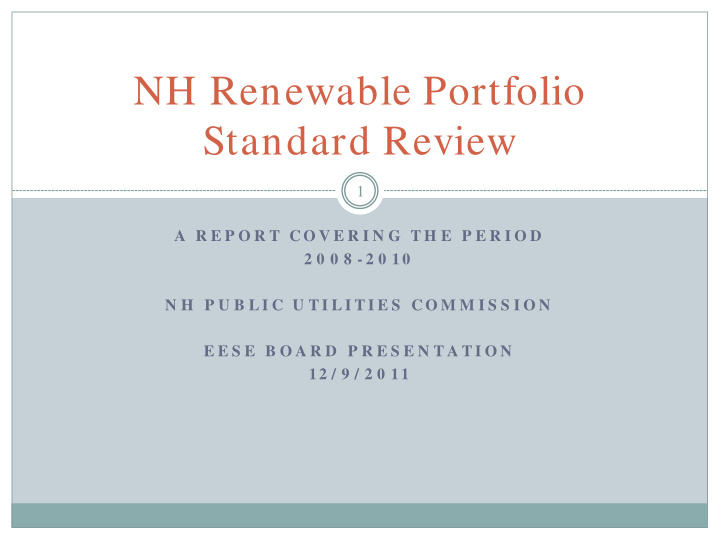



NH Renewable Portfolio Standard Review 1 A R E P O R T CO V E R I N G T H E P E R I O D 2 0 0 8 - 2 0 10 N H P U B L I C U T I L I T I E S C O M M I S S I O N E E S E B O A R D P R E S E N T A T I O N 12 / 9 / 2 0 11
RPS Background 2 RPS requires electric utilities and competitive energy suppliers to purchase RECs equivalent to a % of annual retail electric sales RECs = Renewable Energy Certificates = 1 MWh 4 separate resource classes (new & existing) Eligible renewable energy = wind, solar, small hydro, biomass, etc. (that produce electricity). ACPs REF Rebate programs and RFPs
2011 RPS Review 3 RPS Statute mandated a review with a report to the legislature, due November 1, 2011 Review includes 9 categories for investigation: Class requirements and resource supply adequacy Addition of thermal or EE components REF distribution Alternative methods of RPS compliance; etc. Review process included 5 public workshops and dozens of written comments over 5 months
Key Findings: Resource distribution regional; REC supply adequate (except Class IV) 4 Class IV Class I : 38% of capacity in NH NH, 3% NH Facilities: 1 (.75 MW) NE Facilities: 12 (26 MW) New NY Facilities: 0 England 97% Class II NH Class III 0.83 MW New York 11% 21% NH 51% New England 28% New England NH Facilities: 7 (69 MW) 7.05 MW NE Facilities: 6 (37 MW) 89% NY Facilities: 6 (28 MW)
Key Findings: RPS costs are low per kWh 5 Average 2010 RPS cost: $0.0015/ kWh ($0.75/ month if you use 500 kWh, on average)
Key Findings: Compliance met with mostly RECs 6 Utilities met 98% of their compliance with RECs in 2010 CEPs met 67% of compliance with RECs in 2010
Key Findings: RECs trending low; ACPs unpredictable 7 REC prices trending low CEPs pay higher REC prices, on average, than utilities Class III and IV ACPs generate most REF $$
Public stakeholder feedback 8 Public Stakeholders want: TLC: transparency, longevity and consistency Flexibility Mechanisms that support NH energy resources A streamlined method for small generators to create and sell RECs is critical <1 MW solar REC certified while 2.35 MW solar is net-metered Some stakeholders want thermal energy and/ or CHP included Public Stakeholders do not want EE in the RPS
NH Resources: Biomass 9 Changes in MA RPS may exclude significant regional biomass resources from selling into the MA RPS. Class III REC prices near (~$25) ACP in 2010, recent data suggests RECs now trending lower; 6.5% peak requirement reached this year. Significant uncertainty on future of Class III supply/ prices. Large potential for thermal biomass and/ or CHP
NH Resources: Hydropower 10 New hydro currently not eligible under NH RPS Class IV has 1 NH facility (Cocheco Falls, Dover NH) Class IV 1% requirement peaked in 2009 Currently hundreds of undeveloped potential micro- hydropower sites in NH (< 1 MW) DOE: 50+ undeveloped sites <100 kW and 38 sites >100 kW and<1 MW Need to balance ecosystem, recreational, economic development and energy goals accordingly
NH Resources: Solar & Wind 11 Class II for solar electric: supply tracking demand Strong consumer demand & economic development component Need for rule clarification on allowed PPAs under rebate programs 30 25 Megawatts 20 15 10 RPS Requirements Cumulative Capacity 5 0 Class I wind in NH: Lempster (2008, 24 MW) Pending: 281 MW over 7 projects in ISO-NE Interconnection Queue
Commission Recommendations 12 Recom m endation : Given the widely recognized value in New Hampshire’s hydropower resources, keep Class IV in place, but study the implications of no longer requiring fish passage if FERC has exempted a facility from installing fish passage. ALSO, study effects of including microhydro resources in Class I. Recom m endation: Clarify the extent of the RPS obligations beyond 2025, specifically, whether or not the 2025 obligations continue indefinitely absent further legislative change. Recom m endation: Amend RSA 362-F:6 to allow the PUC to devise alternative method(s) of tracking or accounting for Class II RECs, such as engineering production estimates, for systems under 5 kW in gross nameplate capacity. Recom m endation: Require self-suppliers to comply with all RPS supplier requirements for RECs corresponding to their load. Clarify the definition of provider of electricity under RSA 362-F:2, XIV to include customers who meet their retail load through direct purchases from the wholesale market. Recom m endation: Study ways in RPS could be expanded to include pure thermal renewable resources. Rule Change: Clarify Puc 2507 to allow third-party owners to receive REF incentive payments.
Questions? 13 For the full report: www.puc.nh.gov (Link is on the homepage) Kate Epsen Kate.epsen@puc.nh.gov
Recommend
More recommend